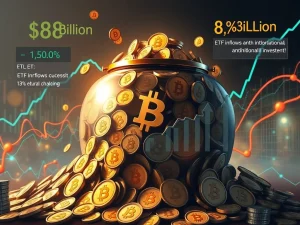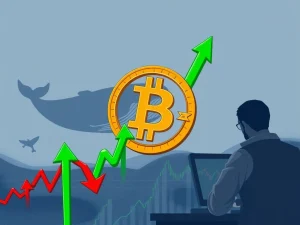Urgent Warning: Altcoin Listings Trap Crypto Exchanges in a Never-Ending Memecoin Cycle

Are you a crypto enthusiast following the latest trends in digital assets? Ever wondered why crypto exchanges list so many altcoins, including the seemingly frivolous memecoins? Well, the CEO of River Financial, a Bitcoin-only financial institution, has dropped a bombshell. He argues that once a crypto exchange starts down the path of altcoin listing, it’s like stepping onto a ‘forever hamster wheel.’ Let’s dive into why this Bitcoin proponent believes listing altcoins can be a trap for crypto exchanges.
The ‘Forever Hamster Wheel’ of Altcoin Listing: What’s the Fuss?
According to River Financial CEO Alex Leishman, the problem starts when an exchange lists its first altcoin, like Ethereum (ETH) or Solana (SOL). In a recent X post, Leishman stated that once an exchange supports these major altcoins, it logically needs to list the numerous tokens built upon their ecosystems. This, he argues, initiates an endless cycle – the ‘forever hamster wheel’ – primarily driven by the demand for memecoin trading.
Key Takeaway: Listing one altcoin opens the floodgates for many more, especially memecoins, creating a never-ending cycle of new listings to chase fleeting trends.
Why Does Listing ETH and SOL Lead to a Memecoin Frenzy?
Leishman’s argument hinges on the interconnected nature of blockchain ecosystems. Think of it like this:
- Ecosystem Logic: Ethereum and Solana aren’t just cryptocurrencies; they are platforms. They host thousands of other tokens. If a crypto exchange lists ETH and SOL, users will naturally expect access to popular tokens within these ecosystems.
- Demand for Variety: Traders, especially those interested in quick gains, often seek out newer, more volatile assets. This naturally leads to demand for memecoin listings, as these tokens often promise (or at least hype up) rapid price increases.
- Competitive Pressure: Exchanges compete for users and trading volume. If one exchange lists a hot new memecoin, others might feel pressured to follow suit to avoid losing customers and market share.
This creates a snowball effect. What starts with listing established altcoins can quickly devolve into a race to list every trending memecoin, regardless of its long-term viability.
River Financial’s Bitcoin-Only Stance: A Contrasting Approach
River Financial stands out by adopting a Bitcoin-only model. They focus solely on buying and selling Bitcoin (BTC), explicitly avoiding the altcoin market. Leishman contrasts this approach with what he calls the “crypto casino” model. He argues that many multi-asset platforms prioritize short-term speculation and transaction fees over helping users build long-term wealth.
Bitcoin-Only Exchanges: Examples
- River Financial: Focuses exclusively on Bitcoin services.
- Swan Bitcoin: Another prominent Bitcoin-only platform.
- Bull Bitcoin: Canadian exchange dedicated to Bitcoin.
- Bisq: A decentralized exchange also prioritizing Bitcoin.
These platforms believe in the long-term value proposition of Bitcoin and aim to provide a focused and secure environment for Bitcoin accumulation.
The ‘Casino Business Model’ vs. Long-Term Wealth Building
Leishman argues that the ‘casino business model’ of many crypto exchanges is inherently extractive. It thrives on high trading volumes, often fueled by speculative trading in volatile altcoins and memecoins. In contrast, the Bitcoin-only model is, in his view, about fostering long-term wealth accumulation through a fundamentally sound asset.
Casino Model (Multi-Asset Exchanges):
- Focus: Short-term speculation and high trading volume.
- Revenue Source: Transaction fees from frequent trading, including altcoins and memecoins.
- Customer Relationship: Transactional, geared towards maximizing trading activity.
Bitcoin-Only Model:
- Focus: Long-term wealth accumulation and Bitcoin adoption.
- Revenue Source: Potentially lower transaction fees but focuses on long-term customer relationships and Bitcoin services.
- Customer Relationship: Advisory and long-term, aiming to educate and support Bitcoin holders.
Critics and the Memecoin Reality Check
Leishman’s critique isn’t new. Even during the memecoin craze of early 2024, voices within the crypto space expressed concerns. Eddy Lazzarin, CTO of A16z, famously described memecoins as looking “like a risky casino,” arguing they detract from the original, more ambitious vision of cryptocurrency.
Memecoin Market Downturn: A Sign?
The data suggests a cooling off in the memecoin market. According to CoinMarketCap:
- The overall memecoin market cap is down nearly 49% since January 1, 2025.
- The market cap stood at $48.49 billion at the time of reporting.
- It’s down 27.94% over the past 12 months.
This downturn might indicate that the memecoin frenzy is losing steam, potentially validating concerns about their long-term sustainability.
The Lucrative Side of Altcoins: Robinhood’s Example
However, the allure of altcoin listing for crypto exchanges is undeniable, primarily due to revenue generation. Robinhood, which offers a range of cryptocurrencies, reported a staggering 700% year-over-year surge in Q4 2024 cryptocurrency revenue. This demonstrates the immediate financial benefits of offering a diverse range of crypto assets, including altcoins.
Robinhood’s Crypto Revenue Surge (Q4 2024): 700% year-over-year
This revenue boost highlights the trade-off: while the ‘hamster wheel’ of altcoin listing might lead to short-term speculative frenzy, it also generates significant income for exchanges.
Memecoin Listings as Validation? Binance Example
Adding another layer to the complexity, some traders perceive a memecoin listing on a major crypto exchange like Binance as a form of validation. On-chain analyst Ai_9684xtpa noted that among 15 memecoins listed by Binance in 2024, 12 experienced significant price increases post-listing. This suggests that exchange listings can indeed fuel memecoin rallies, further incentivizing exchanges to list them.
The Power Law and Memecoin Futures: A Risky Gamble?
CoinGecko founder Bobby Ong recently speculated that the memecoin market might be heading towards an “extreme case of power law.” This implies that a vast majority (99.99%) of memecoins are likely to fail, while only a tiny fraction will achieve lasting success and dominance. This power law distribution makes investing in memecoins incredibly risky, more akin to lottery tickets than traditional investments.
Final Thoughts: Escaping the Hamster Wheel?
River Financial CEO’s ‘hamster wheel’ analogy offers a compelling perspective on the challenges faced by crypto exchanges navigating the ever-expanding altcoin landscape. While listing altcoins, especially memecoins, can provide short-term revenue boosts and attract speculative traders, it might also trap exchanges in a cycle of chasing fleeting trends and prioritizing short-term gains over long-term value creation. The Bitcoin-only model presents a starkly different path, focusing on a singular, established cryptocurrency and a longer-term vision. Whether exchanges can, or even should, escape the ‘forever hamster wheel’ of altcoin listing remains a crucial question for the future of the crypto industry.









